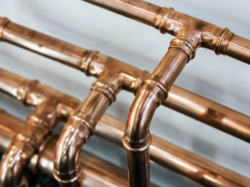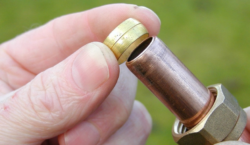Copper pipes are used in the building and construction industry for establishing water supply lines and refrigeration lines in heating, cooling, and air-conditioning systems.
Copper piping and copper pipe fittings are used in both the residential and commercial industries. According to PBC Today, copper piping is a good solution for fire-safe and sustainable piping in buildings.

Image credit
There are three popular types of copper pipe, all with differing thicknesses, and all possessing corrosion resistance. The common types are Type K, Type L, and Type M. A fourth type, the DWV, is used in ground drains, waste, and vent lines.
What is a Type K copper pipe?
This type is the thickest at 0.65 inches and is common in building main water lines or underground installations. It comes as flexible (coiled) and rigid and carries a green stamp. Type K pipes can withstand high water pressure.
What is a Type L copper pipe?
The Type L copper pipe is thinner than Type K. Type L which is medium weight is used in the interior plumbing, fire safety, and heating, cooling, and air-conditioning industries. Carrying a blue mark, this piping can withstand hard water.
What is a Type M copper pipe?
Type M is a thinner and cheaper option than Types K and L. This is used for household water distribution where pressure isn’t a significant factor. It also has good corrosion resistance, so it is a good option for plumbing projects that require durability and longevity.
If you require copper pipe fittings, they can be obtained from a range of suppliers. Copper pipe fittings and other stock are always on-site for easy distribution to industrial engineers and domestic plumbers.

What is copper DWV piping?
Copper DWV piping (drain, waste, and vent) is the thinnest type and is only available in a rigid option. It can only be used for above-ground purposes because it’s not strong or flexible enough to withstand extreme pressure. It’s most commonly found in older homes. This type of piping has almost been eliminated in new construction, having been replaced by the more popular PVC pipe.
